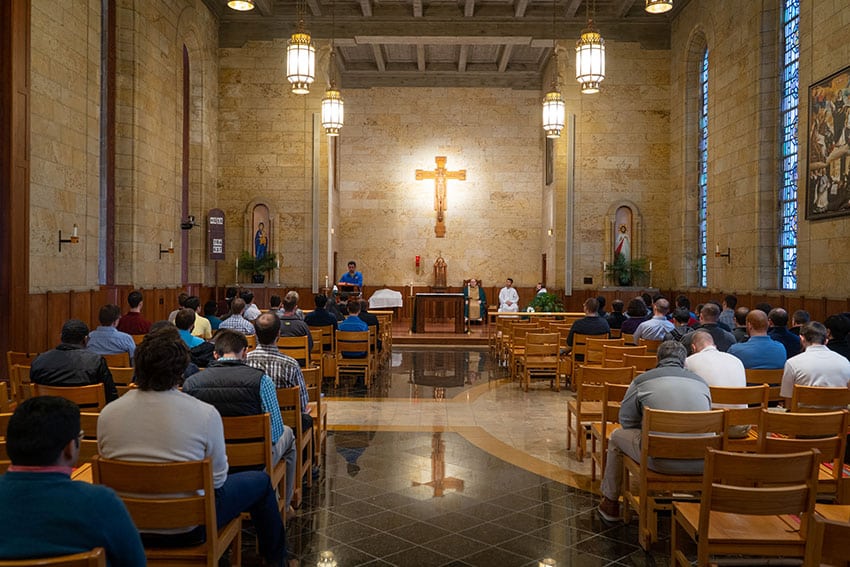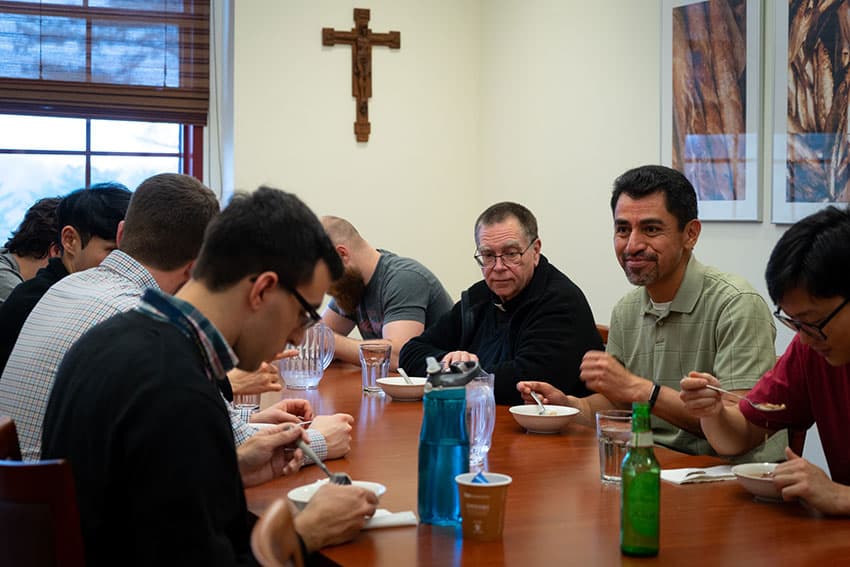Finding the right men
by Fr Brett Brannan

St Vincent de Paul, who was painfully aware that he’d been trained to be an ecclesiastical functionary rather than a pastor, and who realised that that experience had almost destroyed his priestly vocation, once wrote that “there is nothing more perfect than the formation of a good priest.” A holy, well-formed priest is indeed worth his weight in gold. But because grace builds on nature, the screening and selection of candidates for the seminary is of the utmost importance.
Long gone – and thankfully so – are the days described by my “Foreign Born Irish” colleagues, who tell me that their evaluation as a candidate for the priesthood was a four-line, hand-written note from their pastor to the rector of the local seminary: “John is a good lad. He comes from a strong Catholic family. The O’Briens are a respected clan. He will make a fine priest.” And off John went.
Well before 2002, when the sexual abuse scandal erupted in Boston and spread throughout the country, the process of screening candidates for the priesthood and admitting then to seminaries had become much more stringent. Now, it is even more rigorous. It is no exaggeration to say that, in 2019, it is more difficult to become a Catholic priest than a Secret Service agent. The screening and formation of candidates is exhaustive—and often exhausting for the man himself.
Even before a man applies to a seminary, his journey is typically rigorous. Most potential candidates, who likely know many priests and seminarians in their diocese, spend a year or more in serious discernment; this includes attending vocation retreats, meeting regularly with a spiritual director, and establishing a spiritual plan of life. Once a man has completed a careful discernment with the guidance of his spiritual director and the diocesan vocation director has gotten to know him, he – a man already known by his local church – may be invited to apply for acceptance by his diocese as a candidate for priestly formation.
It might be imagined that, given the growing shortage of priests, diocesan vocation directors are tempted to let marginal candidates slide in. In my experience, that is not the case. Having been wounded by the scandal of bad priests, vocation directors feel a tremendous weight of responsibility to select only the best candidates. Seminarians are, of course, human, with their own flaws and failings. But the range of acceptable flaws has been considerably narrowed.
Today’s application process is rigorous, thorough, and usually takes several months to complete. Most dioceses require a complete physical examination, a thorough psychological exam including psychosexual development and sexual history, a lengthy autobiography, letters of recommendation, fingerprinting and a criminal background check, a credit check, and both academic transcripts and sacramental records.
Vocation directors have also become much more discriminating in both the psychological tests that are used and in the mental health professionals they choose to do the psychological examination of a potential candidate. The psychologist needs to be a man of faith who understands the unique stresses of the Catholic priesthood and knows the kind of candidate for which bishops and vocation directors are searching. Thanks to all of this, the final dossier given to the local bishop is usually several inches thick.
And let’s keep in mind that this lengthy process leads only to a man being accepted by his diocese to begin priestly formation. The seminary to which he is sent will have its own admissions process, usually requiring similar information and more. Vocation directors today know that just because they’ve accepted a man as a diocesan candidate for the priesthood does not mean that a seminary will accept him. And after a man has been accepted by both, diocese and seminary, priestly formation continues for six to seven years.
I’ve spent most of my priestly life directly involved in priestly formation. Today, I give retreats for seminarians and priests, and I’ve had the privilege of visiting almost every seminary in the US. My experience in all this has been overwhelmingly positive and suggests to me that priestly formation in the United States today is better than it has been in a long time – better, perhaps, than ever – because the priest-formators in our seminaries are, by and large, holy, well-balanced priests. And I’m impressed by the high quality of the men studying to be priests today.
The reforms that have led to a new era of excellence in American priestly formation are largely due to the genius of St John Paul II and his monumental apostolic exhortation, Pastores Dabo Vobis [I Will Give You Shepherds, or PDV]. Every program of priestly formation in the United States today is based on the principles laid out in PDV, especially its exploration of formation’s four dimensions: human formation, spiritual formation, intellectual formation, and pastoral formation.

Most priest-formators in seminaries today are themselves men inspired by the spirit and teaching of John Paul II. And because they have been well-formed in their own priestly identity and have seen in the late pope an exemplar of priestly holiness, they are better able to form men to be the priests the Church needs and deserves. Orthopraxy follows orthodoxy. A proper priestly identity leads to priestly holiness. And from the vocation director’s point of view, good candidates lead to good priests, as grace builds on nature.
The vocation directors who took up their mission in the 1980s and 1990s – whom I honor for heroic work that was often discouraging – did not have at hand the tools available to vocation directors and seminary rectors today. And while the recruitment and screening process can still be improved, the training of vocation directors today is also better than it has been; one example is the “New Vocation Directors Institute,” a three-day course offered annually by the National Conference of Diocesan Vocation Directors (itself an organization that has been reformed).
This NCDVD course has helped elevate the quality of today’s seminarians by more rigorously educating those whose work is to identify suitable candidates for the priesthood. That work of preparing vocation directors is all the more important when one considers that, of the 177 Catholic dioceses in the United States, about one-quarter appoint a new vocation director every year. Which suggests to me that??, as much as the reformed NCDVD process has helped improve the quality of vocations work, the training given new vocation directors should be even more rigorous and thorough, given the gravity of the judgments these men are called upon to make.
I like to say to men discerning the priesthood that seminary requires about seven thousand hours of prayer before ordination. This includes six to seven years when a man will attend daily Mass, pray a holy hour before the Blessed Sacrament, pray the Divine Office and the rosary, etc. Those numbers have good shock value when I’m giving retreats, but they’re really not hyperbolic. Seminarians today really do pray this much. The Church’s theology of the priesthood cannot be learned in the classroom alone; a man must learn it on his knees in the chapel.
My experience has taught me that candidates today really desire the priestly identity and holiness that is revealed in Christ, the Master. And surprising as it may seem to some, my experience also tells me that seminarians want to live apostolic celibacy and live it well. In all my years of work in various forms of priestly formation, I have never heard a seminarian say, “I wish the Holy Father would allow us to get married.” But I have heard many say, “Father, pray for me for the grace to live the priesthood as Christ intended. Pray that I may have purity of heart.”
Vocation directors in 2019 are entirely aware of the damage that has been caused, and is caused, by bad priests. As my predecessor in the office said when I became vocation director in the diocese of Savannah: “My greatest gift to the priesthood in this diocese is not who I got in, but who I kept out.” Priest vocation directors are gatekeepers, and they acutely feel the pressure caused by the abuse scandals. These men have suffered with the Church, as have so many others. And because of that suffering, vocation directors, seminary rectors, and bishops are much less willing to accept marginal candidates than they were in 1992. Vocation directors and formators of priests today know that, if they are going to err, they should err in favor of the Church.
Father Brett Brannan was vocation director in the Diocese of Savannah, Georgia, for ten years and vice rector of Mount St. Mary’s Seminary in Maryland for six years. He has written two books: To Save a Thousand Souls: A Guide for Discerning a Vocation to Diocesan Priesthood (2010) and A Priest in the Family: A Guide for Parents Whose Sons are Considering Priesthood (2014). A retreat master for diocesan priests’ retreats and for seminaries, he is currently the pastor of Blessed Sacrament Church in Savannah.
